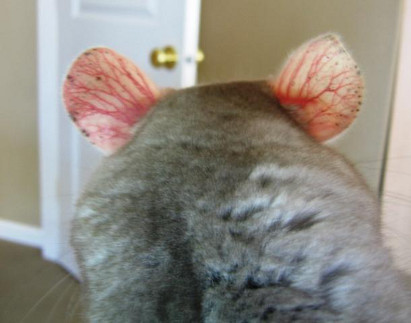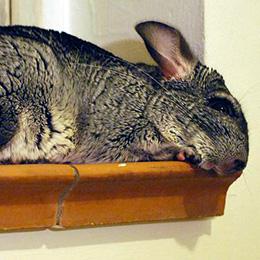Signs and Symptoms of Overheating

Red Ears are a sign that the chinchilla is to hot.
- Red ears
- Sprawled out on its side
- Heavy breathing
If symptoms of overheating are present, the chinchilla should be taken to a cooler area immediately or provided with a means of cooling itself down. Some methods include, but are not limited to the following:
- Take the chinchilla to an air conditioned room
- Place cool tiles in the cage for the chinchilla to lie on
- Place frozen water bottles, covered in fleece, in the cage so the chinchilla can sit near them.
- Fill the water bottle with cool water.
- Hold the chinchilla in front of an open refrigerator until the redness in its ears fades.
Signs and Symptoms of Heat Stroke (in addition to those listed above)
- Lethargy / little energy to move
- Unresponsive
- Unable to stand or walk
- Drooling
- Seizures / twitching
- No prior signs of illness
Not all of the symptoms listed need to be present for the chinchilla to be suffering from heat stroke. If the chinchilla exhibits some of the symptoms of heat stroke and signs of overheating, immediately take action to cool the animal.
- Find a bowl or basin that is large enough to hold the chinchilla and cool water.
- Fill the basin with cool water. Do not add ice or use water that has been in the refrigerator or freezer. Water that is too cold could cause more harm than good by shocking the chinchilla.
- Submerge the chinchilla in the water keeping its head out of the water so it can breathe.
- Keep the chinchilla submerged for a minimum of 15 to 20 minutes. This is necessary to get the chinchilla’s temperature down to normal levels.
- Once the chinchilla has cooled down, dry the fur thoroughly with a towel. Do not use a blow dryer. The heat from a blow dryer can actually overheat the chinchilla again.
- If the chinchilla will take it, give it some cool water to drink.
- Take the chinchilla to an exotics veterinarian to be checked as soon as possible. This is an emergency and should be treated as such. If it is not possible to get to a veterinarian, place the chinchilla is a cool, draft free area. The temperature should be between 68 and 72 degrees Fahrenheit. Keep a close eye on it for the next several hours or until a veterinarian is available. Try not to disturb the chinchilla too much so it can rest.

This overheated chinchilla is trying
to cool off by stretching out on
a tiled surface. Note the red
in the lighter parts of its ears
indicating that the chinchilla is too hot.
Prevention
Overheating and heat stroke are both very dangerous for a chinchilla and can happen quite quickly at temperatures that feel normal for humans. Additionally, chinchillas can overheat in temperatures that are considered safe if they are running, jumping, running on a wheel, in an exercise ball, or if the humidity is higher than normal. This can happen regardless of whether the chinchilla is out of the cage or running loose for playtime.
It is quite easy to prevent overheating and heat stroke in chinchillas. Following is a list of preventative measures that can be taken to keep chinchillas from overheating.
- Always keep chinchillas in an air conditioned room. Make sure the thermostat keeps the temperature no higher than 72 degrees Fahrenheit.
- Lower the room temperature by at least 5 degrees prior to playtime.
- Supply the chinchilla with a “chin chiller”. This is a granite or marble slab that is placed in the cage for the chinchilla to lie on and cool itself when necessary. A marble, granite or ceramic tile or can be used in place of a “chin chiller”. It is a good idea to have a second tile in the freezer for additional cooling. The tiles can be swapped out periodically.
- Freeze plastic bottles filled with water. These can be covered in fleece and placed in the chinchilla’s cage if needed on days when the air conditioning can not keep up, is broken, or there is a power outage.
- Have ice packs handy in case the chinchilla begins to overheat. Place a towel over the ice pack and place the chinchilla on the towel. Do not leave ice packs in the cage without close supervision. Most are filled with harmful materials that can cause serious problems if the chinchilla chews on the ice pack.
- Do not transport chinchillas in vehicles that do not have working air conditioners.
- Do not place the cage in front of a window or near a heater vent or radiator.
- Do not use an exercise ball. Chinchillas overheat in them in a matter of minutes.



 Site Last Updated on December 31, 1969 05:00 pm
Site Last Updated on December 31, 1969 05:00 pm